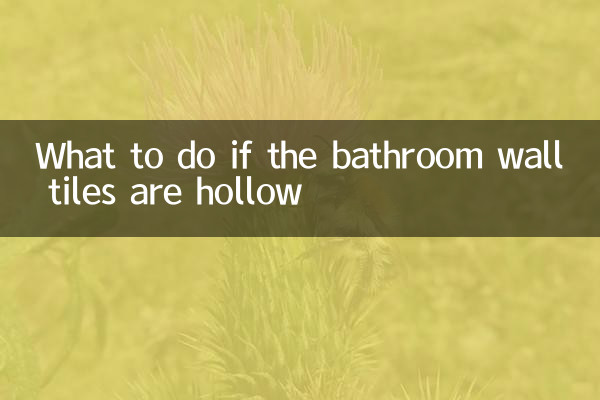What to do if the bathroom wall tiles are hollow? ——A complete guide to cause analysis and solutions
Recently, the topic of home decoration has continued to rise in popularity, among which "hollow bathroom wall tiles" has become a focus issue among netizens. This article will combine the hot discussion data from the entire Internet in the past 10 days to provide you with a detailed analysis of the causes, hazards and repair methods of hollow wall tiles, and provide structured data reference.
1. Common causes of hollow wall tiles

According to decoration forums and interviews with experts, hollow drum problems are mostly caused by the following factors:
| Ranking | reason | Proportion |
|---|---|---|
| 1 | Improper substrate treatment (dust or moisture) | 42% |
| 2 | Wrong cement mortar ratio | 28% |
| 3 | Ceramic tiles not fully soaked | 15% |
| 4 | Construction temperature is too low | 10% |
| 5 | Insufficient maintenance time | 5% |
2. Classification of hollow drum hazards
Depending on the hollow area and location, the hazards can be divided into three levels:
| Hazard level | Hollow area | possible consequences |
|---|---|---|
| Mild | Single brick area ≤10% | No impact on appearance, no safety hazard |
| Moderate | Single brick area 10%-30% | May cause water seepage and mold |
| Severe | The area of a single brick is ≥30% or multiple consecutive bricks | High risk of tiles falling off |
Three or five steps to solve the problem of wall brick hollowing
Step 1: Accurate Diagnosis
Use a rubber mallet to lightly tap the tiles and identify the location of the hollows through the sound (a hollow sound is abnormal).
Step 2: Classification processing
- Hollow corners: You can try pouring special tile adhesive
- Center hollow drum: needs to be replaced as a whole
- Large areas are hollow: it is recommended to resurface the wall
Step 3: Professional Restoration Process
| Tool materials | Operational points | time consuming |
|---|---|---|
| Suction cup, cutting machine | Carefully remove hollow bricks from edges | 20-40 minutes/block |
| toothed scraper | Clean the base and reapply the adhesive | Need to match the curing time |
Step 4: Key Considerations
1. Be sure to wear goggles to prevent flying debris
2. Be especially careful near water and electricity lines
3. It is recommended to choose construction in the morning to ensure sufficient drying time.
Step 5: Acceptance Criteria
Acceptance will be carried out 24 hours after repair:
- No hollow sound when struck
- No water seepage at the seams
- There is no height difference between adjacent tiles
4. Three key points to prevent hollowing
Recommendations based on the latest construction regulations:
| construction stage | Precautions | Effect |
|---|---|---|
| Preliminary preparation | Wall roughening treatment + interface agent | Improve adhesion by 80% |
| Material selection | Use C2 grade tile adhesive | Reduce empty drum rate by 60% |
| Later maintenance | No touching the water for 3 days | Guaranteed strength development |
5. Selected popular questions and answers
Q: Can I use the bathroom immediately after repairing the hollow drum?
A: It is recommended to wait at least 48 hours, especially the shower area will take longer.
Q: What is the success rate of DIY repair?
A: The success rate of DIY hollowing out of small areas at corners is about 70%. However, for large areas, it is recommended to hire a professional bricklayer (market price is about 80-150 yuan/square meter).
Q: Is the new tile adhesive better than traditional cement?
A: Experimental data shows:
- The emptying rate of tile adhesive is 3-5%
- Cement mortar void rate is 15-20%
However, it should be noted that there are special process requirements for ceramic tile adhesive construction.
Through the above system analysis, I believe you have a comprehensive understanding of the problem of bathroom wall tile hollowing. It is recommended that regular inspections and early detection and early treatment can ensure the safety and beauty of the home environment.

check the details

check the details